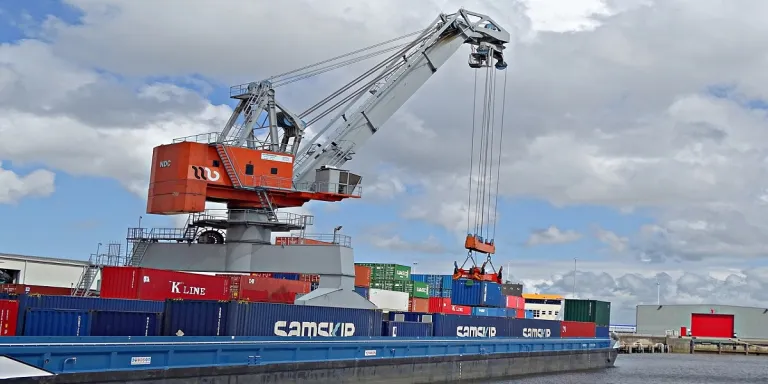If you own a boat, a boat yard, or you supply to the boating community, you likely already know about boat gantry cranes. But do you know which specific type is suitable for you or your business? Here, we’ll offer guidance on the different types of boat cranes on the market, and cover the key characteristics to consider before buying one.
Table of Contents
An overview of the boat gantry crane market
What is a boat gantry crane
Types of boat gantry cranes
Summary
An overview of the boat gantry crane market

The global boat crane market size is projected to grow at a compound annual growth rate (CAGR) of 3.5% from USD 156.3 million in 2022 to USD 213.1 million in 2031. There was a marked slump during the pandemic due to the effects of lockdown, but sales are now seeing a significant bounce back, with the marine leisure industry seeing growth as well as the boat-building industry.
What is a boat gantry crane
Boats need to be moved out of the water to dry dock for maintenance and repair, for anti-fouling (removing barnacles and other marine growth from the hull), or around a boatyard for storage. And, of course, they need to be moved back into the water.
The main way to lift a boat from the water is to use a boat gantry crane. A gantry crane is a generic term for a type of crane with a structure that straddles a space or object. Boat gantry cranes are therefore gantry cranes specifically designed to straddle a boat, either resting in water or in a storage space.
Boat gantry cranes, also called marine gantry cranes, boat hoists, travel lifts, or just boat cranes, are the lifting mechanism of choice for moving boats in and out of the water, and around the boatyard.
The two normal methods of lifting the boat are:
- By driving the gantry crane down a sloped slipway to retrieve the boat from the water’s edge
- For the boat to be moved into a lifting well – a narrow docking area at water level – where it is raised about the ground level by the gantry crane
Boat gantry cranes are designed in a U-shape (sometimes referred to as a door frame), made up of two side metal frames and a single cross spar holding them together. This structure allows for a boat to be lifted between the gantry frame, while the open end to the frame allows for a high sailing mast or tall superstructure to move into the gantry without obstruction.
For mobility, the gantry frame has groups of steerable wheels on each corner. Smaller gantries may have only one wheel per corner, and larger gantries up to four wheels per corner.
The boat is lifted using a harness or straps that are passed under the hull, for then to be lifted using a wire rope winching mechanism. The gantry is then moved via its own power source or towed to its new location.
Boat gantry cranes come in a variety of sizes and capacities, from only a few tons capacity that lift small leisure craft, to those with a capacity of thousands of tons to lift large ocean yachts and small ships.
Types of boat gantry cranes
Size
When considering a boat gantry crane, there are a number of size-related aspects to consider. The lifting capacity (tonnage) is especially important as it determines how large a boat can be lifted. The width of the gantry between the main rails, as well as the length or outreach of the frame, determine how wide a body of water and how wide a boat, or yacht, can be lifted.
Boat gantry cranes offer a range of lifting capabilities, from around 10 to 20 tons at their lower range, to up to as much as 1,000 tons. A gantry’s width can be as little as 5 meters or as much as 20 meters, with many suppliers offering customized sizing. Length or outreach is typically between 10 to 50 meters.
The generic model boat gantry crane above from Henan Crane Co. can lift between 10 and 800 tons and sells for around USD 31,800.
This mobile boat hauler (MBH) yacht crane has a 50 to 900-ton lifting capacity and sells for USD 35,000. It has a very wide reach capability, as demonstrated here, spanning two boats simultaneously.
Wheelbase and steering
Larger-sized gantry cranes can have up to four wheels on each corner of their frame, for 16 wheels in total. Smaller cranes may either have a single or pair of wheels at each corner. Most cranes include fully articulated steering at each corner, which allows the entire gantry to be moved forward or back in a straight line, or to be steered hydraulically, either in a circle or obliquely (diagonally). This gives the operator full flexibility in moving a boat around a boatyard once it has been winched out of the water.
The crane above 250-ton yacht crane from Henan Haiti Heavy Industry sells for around USD 100,000. It has 16 fully articulating wheels and is shown here with its wheels aligned, allowing the gantry to rotate in place.
This 500-ton capacity mid-sized crane from Xinxiang Heavy Crane Co. has two wheels at each corner and is advertised at USD 20,000.
Winching mechanism and lifting belts
Boat cranes use an electric-powered winching (hoisting) mechanism to raise, lower, and support a vessel. The winch itself uses steel cables for winding and unwinding the main supports, called main car hooks. Each of these supports will typically hold two or for belts that run under the boat to hold and lift the vessel. These belts are made of natural or synthetic webbed strapping and are designed to be soft so as to not damage the boat hull but firm enough to take the weight.
This 300-ton capacity SWL model boat crane from Henan Dowell Crane Co., available for USD 128,000, has a wide frame with six belt supports on each side. Each support fits two double belt loops, making 24 separate lifting belts in total.
This small capacity 45-ton rubber tired gantry (RTG) boat lift from Henan Mine Crane Co. sells for USD 20,000, and is shown here lifting a small launch with six belt points on each side.
Diesel or electric control
The driving power for a gantry’s wheel assemblies comes from either a diesel or electricity-powered engine. The steering mechanisms are typically hydraulic-driven, and the winching mechanism electric, but there are variations. The power system is usually fitted above or below the lower spar.
The controls can be found along the lower spar on the gantry, or for larger cranes, there may be a complete control cabin on top of the crane or at the front of the gantry structure. There are also remote control options so that the operator can walk alongside the gantry as it moves.
This large 1500-ton MHI boat gantry crane from Henan Modern Heavy Industry and Technology features a diesel power unit on the right-hand side and sells for USD 65,000.
This 500-ton capacity crane has a diesel power unit, electric winches, and a closed control cabin fitted to the lower spar. This model is supplied by Henan Juren Crane Group for USD 150,000.
This 350-ton MBH gantry crane has a closed control cabin and sells for USD 35,000 from Henan Nybon Machinery. The view from the control cabin is clear and unblocked, with joystick controls for each hand.
There are also many remote-control options. For example, the 1200-ton MBH gantry above from Henan Haitai Heavy Industry comes with a standalone control so that the operator can operate and walk alongside the gantry. This model costs USD 180,000.
Summary
Although basic designs remain mostly the same – two rectangular sides connected by a cross spar to make a U-shape – there are many options available when it comes to selecting the right boat gantry crane for your business.
The key factors to consider in sourcing a boat gantry crane are:
- Size: What is the largest vessel needed to be lifted and moved? The gantry’s dimensions will determine how large (length, height, and width) a boat can be fitted within the gantry spars.
- Lift capacity: The tonnage capacity of the overall structure, lifting belts, and winch mechanism will determine how heavy a vessel can be lifted safely
- Steering and controls: The steering ability of the wheels – whether all four corners can be turned or just the front two – will determine how much movement is available for easy maneuverability. These in turn help choose what type of controls will fit best, such as in-cabin to remote control.
As a potential buyer, you will already have a good idea of the type of vessels that are intended to be moved and will be able to narrow down your search to the best size and capacity for your needs.
For more information on a huge selection of boat gantry cranes on the market, check out the online showroom at Alibaba.com.




